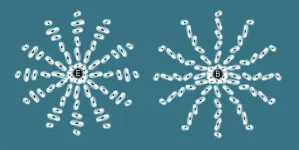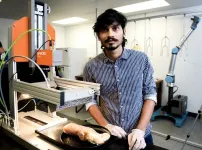(Press-News.org) “The cosmological principle is like an ultimate kind of statement of humility,” explains James Adam, astrophysicist at the University of the Western Cape, Cape Town, South Africa, and lead author of the new paper. According to the Cosmological Principle, not only are we not at the center of the Universe, but a true center does not exist. A further assumption, similar to but distinct and independent from homogeneity, is that the Universe is also isotropic, meaning it has no preferred directions. These assumptions underlie the Standard Model of Cosmology, the theoretical framework used to explain the origin, evolution, and current state of the Universe. It is currently the most robust and consistent model, verified by numerous scientific observations, though not yet perfect.
In fact, some recent cosmological observations suggest that, on extremely large scales, there may be anisotropies—variations in the Universe’s structure that challenge the assumption of isotropy. These anomalies have been identified using different methods and include conflicting measurements of the Universe’s expansion rate, studies of the cosmic microwave background radiation, and various inconsistencies in cosmological data. However, these observations are not yet conclusive. To rule out measurement errors, more data must be collected using independent methodologies. If multiple techniques confirm the same anomalies, their existence would become much harder to dismiss.
The new study published in JCAP by Adam and colleagues developed a new methodology to test the Universe’s isotropy using observations from instruments like Euclid. Euclid is an ESA space telescope launched in 2023, which has just begun producing images of the cosmos with unprecedented power, precision, and resolution.
“We investigated a different method of constraining anisotropy which involved so-called weak gravitational lensing,” says Adam. Weak lensing occurs because matter between us and a distant galaxy slightly bends the galaxy’s light, altering its apparent shape. This specific type of distortion can reveal whether anisotropies exist in the Universe. In fact, the analysis of weak lensing data allows scientists to separate the signal into two components: E-mode shear, which is generated by the distribution of matter in an isotropic and homogeneous Universe, and B-mode shear, which is typically very weak and should not appear on large scales in an isotropic Universe.
Simply observing B-modes on large scales would not be enough to confirm anisotropies, as these signals are very weak and could result from measurement errors or secondary effects. If an anisotropy is real, it would affect both E-modes and B-modes in a non-independent way, generating a correlation between the two signals. Only if Euclid’s data reveal a significant correlation between E- and B-modes would it suggest an anisotropic expansion of the Universe.
Next Steps and Possible Implications
In their study, Adam and colleagues simulated the effects of an anisotropic universe expansion on a computer and developed a model describing how deviations from isotropy would modify the weak lensing signal. They then calculated the E-B cross-correlation to demonstrate that an anisotropic universe would produce a correlation between the two signals, and applied their model to future Euclid data, showing that these observations will be precise enough to detect potential anisotropies.
Euclid is already beginning to provide useful data for these analyses, and new observatories will soon come online. Now that they have developed the proper methodology, Adam and his colleagues intend to apply it to real data. “Once you’ve kind of quadruple-checked your work, then you have to seriously consider whether this fundamental assumption is actually true or not, particularly in the late Universe. Or perhaps it just was never true”, explains Adam.
If these anomalies are confirmed, they would open a new chapter in cosmology. It won’t be easy, though: there are already alternative theoretical models that predict anisotropies, but none are as solid or widely accepted as the Standard Model. However, any theoretical revision would also depend on the extent of the anisotropy that could be detected, which remains uncertain.“It could be a serious revision,” concludes Adam, "or just adding a little term here or there. Who knows?”
If you want to learn more…
The Cosmological Principle
We know that the Universe is expanding, and this might lead us to mistakenly imagine that there is a center (where the Big Bang occurred) from which this expansion originated. Instead, we should think of our Universe as if it were the surface of the Earth: we can move in any direction without ever reaching an edge, but there is no center on the surface. If Earth behaved like a balloon being inflated, we would see that the space on its surface expands, but there would be no specific point on it that could be considered the center of the expansion.
According to the Cosmological Principle, not only is there no center or privileged location in cosmic space, but space itself has homogeneous properties everywhere, at least on sufficiently large scales. We know that there are voids and dense regions, such as galaxies and the space between them, but if we zoom out—just like we zoom out on a smartphone with two fingers—these inhomogeneities disappear. This principle forms the foundation of the theoretical model we use today to explain the origin, evolution, and current state of the Universe. It is also very convenient because it implies that the laws of physics apply everywhere in the same way, significantly simplifying our understanding of the cosmos.
Weak Lensing
Weak lensing is based on the principle, described by general relativity, that gravity can bend the path of light. The greater the mass of a celestial body, the stronger the distortion of light passing near it. Galaxies and other objects located behind a massive gravitational field appear subtly distorted, with their shapes and orientations slightly altered.
This effect is similar to looking at an object through a magnifying glass. Just as the curved surface of the lens bends and distorts light, changing the apparent shape and position of objects behind it, the gravitational field of a massive cosmic structure bends and distorts the light from distant galaxies. As a result, an elliptical galaxy may appear slightly squished or rotated.
By carefully analyzing these distortions across billions of galaxies, surveys like Euclid and LSST can detect weak lensing, revealing the presence and distribution of unseen matter, including dark matter.
END
Does the universe behave the same way everywhere? Gravitational lenses could help us find out
A JCAP study proposes a test for the Cosmological Principle using weak gravitational lensing
2025-02-11
ELSE PRESS RELEASES FROM THIS DATE:
Majority support moderation on social media platforms
2025-02-11
Most people want harmful social media content such as physical threats and defamation to be restricted. This also applies in the USA where several social media platforms have recently modified their policies in favor of unrestricted free speech. However, the majority of users believe that intolerance and hate have become unavoidable on social media. This was revealed in a large-scale survey conducted by the Technical University of Munich (TUM) and the University of Oxford in 10 countries in Europe, America, Africa and Australia. The study also highlights differences among countries.
The global debate on whether and how social media content should ...
Majority support moderation on social media platforms, global survey shows
2025-02-11
UNDER EMBARGO UNTIL 4:00 AM GMT TUESDAY 11 FEBRUARY / 23:00 ET MONDAY 10 FEBRUARY 2025
A new large-scale, global survey has revealed that most people want harmful social media content such as physical threats and defamation to be restricted.
This also applies in the USA where several social media platforms have recently modified their policies in favor of unrestricted free speech.
However, the majority of users believe that intolerance and hate have become unavoidable on social media.
This study, conducted ...
Born too late? Climate change may be delaying births
2025-02-11
New Curtin University research has found exposure to outdoor air pollution and extreme temperatures during pregnancy may increase the risk of prolonged pregnancy, offering new insights into the impact of climate change on maternal health.
The study analysed data from nearly 400,000 births in Western Australia and found that higher exposure to fine particulate air pollution (PM2.5) and biothermal stress (a measure that combines air temperature, radiant temperature, relative humidity, wind speed, and human physiology) was associated ...
Truly autonomous AI is on the horizon
2025-02-11
Researchers have developed a new AI algorithm, called Torque Clustering, that is much closer to natural intelligence than current methods. It significantly improves how AI systems learn and uncover patterns in data independently, without human guidance.
Torque Clustering can efficiently and autonomously analyse vast amounts of data in fields such as biology, chemistry, astronomy, psychology, finance and medicine, revealing new insights such as detecting disease patterns, uncovering fraud, or understanding behaviour.
“In nature, animals learn by observing, exploring, and interacting with their ...
California’s marine protected areas boost fish populations across the state
2025-02-11
(Santa Barbara, Calif.) — It’s 1999, the 21st century is on the horizon, and California has big plans for marine conservation. New legislation has presented a mandate to establish an ambitious network of marine protected areas (MPAs) unlike anywhere else in the world. The goal is to craft strategic protections to safeguard the state’s marine life for preservation and economic benefits alike.
Now 25 years later, an international team of researchers, led by scientists at UC Santa Barbara, have evaluated the network’s ...
Poachers’ social media posts reveal alarming extent of illegal wildlife hunting in Lebanon
2025-02-11
Public posts on social media platforms shed light on the extent and nature of prolific illegal wildlife hunting in Lebanon, research in Oryx—The International Journal of Conservation, published by Cambridge University Press on behalf of Fauna & Flora, has found.
The study is the first to use social media as a tool for assessing illegal hunting activities in Lebanon. The country, along with the Mediterranean region more broadly, is a global poaching blackspot, particularly for the illegal killing of protected ...
Examining the potential environmental effects of mining the world’s largest lithium deposit
2025-02-11
DURHAM, N.C. -- The world’s largest known lithium deposit exists within a vast salt pan called the Salar de Uyuni, which stretches for thousands of square miles atop a high, dry Andean plateau in Bolivia. For most of the year, salt crystals encrust the terrain, white as confectioner’s sugar. During the wet season, pooling rainwater mirrors surrounding mountains and sky.
“The Salar is a magical place for travelers from all over the world who come to see the colors, the reflections, in this endless white landscape,” said Avner Vengosh, Nicholas Chair of Environmental Quality at the Duke University ...
Chicken ‘woody breast’ detection improved with advanced machine learning model
2025-02-11
FAYETTEVILLE, Ark. — It’s called “woody breast” and for consumers it can mean a chewier chicken sandwich, but for the industry it can mean up to $200 million annual yield loss.
Work done by the Arkansas Agricultural Experiment Station is not only making woody breast easier to detect in chicken meat but is accurate up to 95 percent of the time.
The development could help improve quality assurance and customer confidence in one of the state’s most economically important agricultural products. What allows ...
Around 1 in 5 UK medical students considers dropping out, study suggests
2025-02-11
Around 1 in 5 UK medical students considers dropping out of medical school, with mental health issues a key contributor to their intention to abandon medicine, suggest the results of an observational study published in the open access journal BMJ Open.
The shortage of doctors worldwide is a major cause for concern, say the researchers, with the current shortfall thought to be around 6.5 million.
These shortages not only affect the quality of patient care, but also doctors’ wellbeing as a result of increased workload and chronic stress, which further undermine recruitment and retention, creating a vicious circle, they add.
Given that medical ...
Poor childhood social and cognitive skills combo linked to teens’ poor exam results
2025-02-11
The combination of poorly developed social and cognitive skills during childhood is linked to poor exam results by the age of 16, with those for whom these issues persist throughout their childhood more than 4 times as likely not to pass at least 5 GCSEs, finds research published online in the Archives of Disease in Childhood.
The findings, which are based on a large set of nationally representative data, suggest that childhood cognitive and behavioural issues may be behind 17% of GCSE (General Certificate of Secondary Education) exam fails among 16 year olds, conclude the researchers.
“Years in school matter, not just for exam results, but for skills and capacity development. ...
LAST 30 PRESS RELEASES:
Scalable and healable gradient textiles for multi‑scenario radiative cooling via bicomponent blow spinning
Research shows informed traders never let a good climate crisis go to waste
Intelligent XGBoost framework enhances asphalt pavement skid resistance assessment
Dual-function biomaterials for postoperative osteosarcoma: Tumor suppression and bone regeneration
New framework reveals where transport emissions concentrate in Singapore
NTP-enhanced lattice oxygen activation in Ce-Co catalysts for low-temperature soot combustion
Synergistic interface engineering in Cu-Zn-Ce catalysts for efficient CO2 hydrogenation to methanol
COVID-19 leaves a lasting mark on the human brain
Scientists use ultrasound to soften and treat cancer tumors without damaging healthy tissue
Community swimming program for Black youth boosts skills, sense of belonging, study finds
Specific depressive symptoms in midlife linked to increased dementia risk
An ‘illuminating’ design sheds light on cholesterol
Who is more likely to get long COVID?
Study showcases resilience and rapid growth of “living rocks”
Naval Research Lab diver earns Office of Naval Research 2025 Sailor of the Year
New Mayo-led study establishes practical definition for rapidly progressive dementia
Fossil fuel industry’s “climate false solutions” reinforce its power and aggravate environmental injustice
Researchers reveal bias in a widely used measure of algorithm performance
Alcohol causes cancer. A study from IOCB Prague confirms damage to DNA and shows how cells defend against it
Hidden viruses in wastewater treatment may shape public health risks, study finds
Unlock the power of nature: how biomass can transform climate mitigation
Biochar reshapes hidden soil microbes that capture carbon dioxide in farmland
Reducing saturated fat intake shows mortality benefit, but only in high-risk individuals
Manta rays create mobile ecosystems, study finds
Study: Mixed results in using lipoic acid to treat progressive multiple sclerosis
Norbert Holtkamp appointed director of Fermi National Accelerator Laboratory
New agentic AI platform accelerates advanced optics design
Biologists discover neurons use physical signals — not electricity — to stabilize communication
Researchers discover that a hormone can access the brain by hitchhiking
University of Oklahoma researcher awarded funding to pursue AI-powered material design
[Press-News.org] Does the universe behave the same way everywhere? Gravitational lenses could help us find outA JCAP study proposes a test for the Cosmological Principle using weak gravitational lensing




